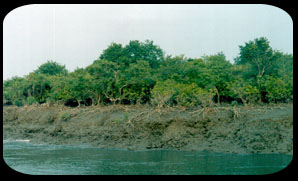 River Matla divide Sundarban kept Forest into Sundarban Tiger Reserve (on the east) and Reserved Forest of South 24 Parganas Forest Division .Sundarban, the biggest delta in the world, consists of 10,200 sq km of Mangrove Forest , extend over India (4200 sq km of Reserved Forest ) and Bangladesh (6000 sq km approx of Reserved Forest ) and is also the biggest Mangrove Forest in the world. Another 5400 sq km of non-forest, occupied region in India , beside the north and north-western border of mangrove forest, is also known as Sundarban region in India . Therefore, the total area of Sundarban region in India is 9600 sq km which constitute the Sundarban Biosphere Reserve. Indian Sundarban is spring on the west by river Muriganga and on the east by rivers Harinbhahga and Raimangal. Other main rivers flowing through this flora and fauna are Saptamukhi, Thakuran, Matla and Goasaba.Sundarban Biosphere Reserve was constituted by Government of India (GOI)in 1989 and it conventional the detection of UNESCO under its Man and Biosphere (MAB) Programme in November, 2001. Sundarban National Park , forming the center area of Sundarban Tiger Reserve, acknowledged detection as World Heritage Site by UNESCO in 1987. It has been designated by GOI for recognition as Ramsar Site (a wetland of international importance). Sundarban Tiger Reserve was constituted by GOI under Project Tiger scheme, in 1973. Sundarban is the only mangrove forest in the world which is the residence of Tiger. Sundarban Tiger Reserve has the maximum tiger population in the world. Sundarban has particularly rich assortment of aquatic and terrestrial flora and fauna. Sundarban's highly productive ecosystem acts as a natural fish nursery. Sundarban Mangrove reduces the fury of cyclonic storm and prevents wearing away due to tidal achievement. Finally, millions of people depend on Sundarban Ecosystem for their livelihood and sustenance through fishing, collection of honey and fuel wood /timber.
River Matla divide Sundarban kept Forest into Sundarban Tiger Reserve (on the east) and Reserved Forest of South 24 Parganas Forest Division .Sundarban, the biggest delta in the world, consists of 10,200 sq km of Mangrove Forest , extend over India (4200 sq km of Reserved Forest ) and Bangladesh (6000 sq km approx of Reserved Forest ) and is also the biggest Mangrove Forest in the world. Another 5400 sq km of non-forest, occupied region in India , beside the north and north-western border of mangrove forest, is also known as Sundarban region in India . Therefore, the total area of Sundarban region in India is 9600 sq km which constitute the Sundarban Biosphere Reserve. Indian Sundarban is spring on the west by river Muriganga and on the east by rivers Harinbhahga and Raimangal. Other main rivers flowing through this flora and fauna are Saptamukhi, Thakuran, Matla and Goasaba.Sundarban Biosphere Reserve was constituted by Government of India (GOI)in 1989 and it conventional the detection of UNESCO under its Man and Biosphere (MAB) Programme in November, 2001. Sundarban National Park , forming the center area of Sundarban Tiger Reserve, acknowledged detection as World Heritage Site by UNESCO in 1987. It has been designated by GOI for recognition as Ramsar Site (a wetland of international importance). Sundarban Tiger Reserve was constituted by GOI under Project Tiger scheme, in 1973. Sundarban is the only mangrove forest in the world which is the residence of Tiger. Sundarban Tiger Reserve has the maximum tiger population in the world. Sundarban has particularly rich assortment of aquatic and terrestrial flora and fauna. Sundarban's highly productive ecosystem acts as a natural fish nursery. Sundarban Mangrove reduces the fury of cyclonic storm and prevents wearing away due to tidal achievement. Finally, millions of people depend on Sundarban Ecosystem for their livelihood and sustenance through fishing, collection of honey and fuel wood /timber.

Geologically, the Sundarban delta is the biggest protruding delta on the world. The region is enclosed solely by quaternary sediments conceded and deposited by the rivers Ganges , Matla & Bidyadhari.
Although the region is located south of the Tropic of Cancer, the temperature is composed due to its immediacy to the sea. Average yearly maximum temperature is around 35 C . Average annual rainfall is 1920 mm. Average moisture is about 82% which is more or less consistent throughout the year.
 River Matla divide Sundarban kept Forest into Sundarban Tiger Reserve (on the east) and Reserved Forest of South 24 Parganas Forest Division .Sundarban, the biggest delta in the world, consists of 10,200 sq km of Mangrove Forest , extend over India (4200 sq km of Reserved Forest ) and Bangladesh (6000 sq km approx of Reserved Forest ) and is also the biggest Mangrove Forest in the world. Another 5400 sq km of non-forest, occupied region in
River Matla divide Sundarban kept Forest into Sundarban Tiger Reserve (on the east) and Reserved Forest of South 24 Parganas Forest Division .Sundarban, the biggest delta in the world, consists of 10,200 sq km of Mangrove Forest , extend over India (4200 sq km of Reserved Forest ) and Bangladesh (6000 sq km approx of Reserved Forest ) and is also the biggest Mangrove Forest in the world. Another 5400 sq km of non-forest, occupied region in 


No comments:
Post a Comment